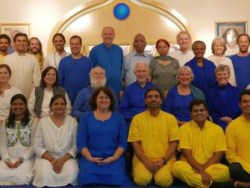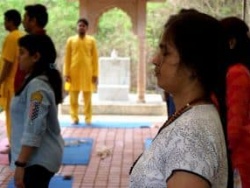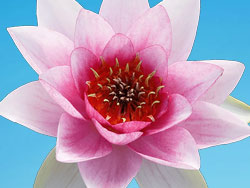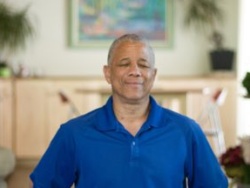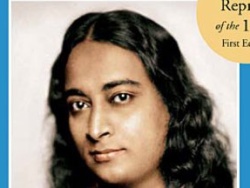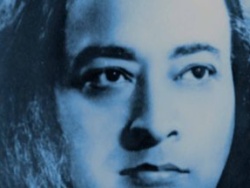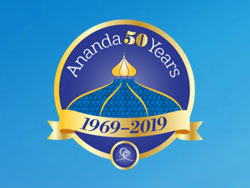Let’s start from the beginning: how did you come into the path?
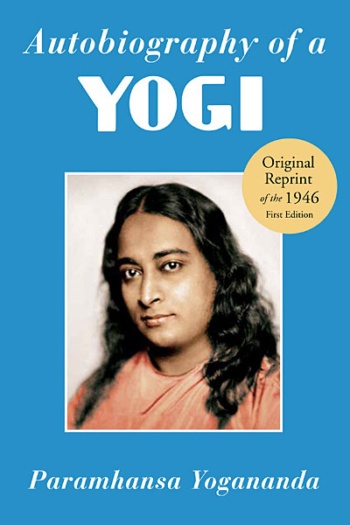 Well, I think there were two things: first of all, of course, the book Autobiography of a Yogi. This was back in 2006. I used to follow the newspapers quite regularly, I was inspired by new stories, and then that interest introduced me to autobiographies. One day I just told myself I want to find a good, inspiring life story, and I found Autobiography of a Yogi, which, to say the least, opened my mind to concepts and vistas like Guru, reincarnation, the possibility of spiritual attainments, etc. Of course, being Indian, I had heard of these things, but just knowing that someone in our century had those experiences was awe-inspiring.
Well, I think there were two things: first of all, of course, the book Autobiography of a Yogi. This was back in 2006. I used to follow the newspapers quite regularly, I was inspired by new stories, and then that interest introduced me to autobiographies. One day I just told myself I want to find a good, inspiring life story, and I found Autobiography of a Yogi, which, to say the least, opened my mind to concepts and vistas like Guru, reincarnation, the possibility of spiritual attainments, etc. Of course, being Indian, I had heard of these things, but just knowing that someone in our century had those experiences was awe-inspiring.
I was very fortunate because, as I was reading the book, I realized that this is really what everybody is seeking, and no matter what their goals in life were so far, this should be added to it.
It was then that I saw an ad of Swami Kriyananda ji, who was going to be in Delhi to give a talk in two weeks: the launch of his book The Essence of the Bhagavad Gita, and I immediately decided to go for that. As soon as I met Kriyananda ji I could see the fruits of living a spiritual life; I can’t define it, but I was at once very impressed by him.
 Of course, in that meeting I was always looking at how these teachings can help other people: is it practical? The Truth exists, but if it exists for a handful of people, I was honestly not very interested. So I picked a book of his, Hope for a Better World, which speaks about intentional communities, and I was very impressed of how he explains the ground realities of a community, while picking it up from a very high point of spirituality. The book also mentions that he had already ran such a community for forty years. So, again, I think that was the book which REALLY brought me on the path.
Of course, in that meeting I was always looking at how these teachings can help other people: is it practical? The Truth exists, but if it exists for a handful of people, I was honestly not very interested. So I picked a book of his, Hope for a Better World, which speaks about intentional communities, and I was very impressed of how he explains the ground realities of a community, while picking it up from a very high point of spirituality. The book also mentions that he had already ran such a community for forty years. So, again, I think that was the book which REALLY brought me on the path.
I introduced myself to Swami ji the next week. Later, I wrote him a letter saying “can I join you?” He didn’t reply to that letter, and so I told myself: “my karma is not good enough to be a meditator, to be close to him,” and I kept doing my surgical posting for the next one and a half years.
Finally, I reached the point in which I felt I had learned my lessons and I now needed to be in the ashram environment. That is when I returned to him and was accepted. I had a role and a place where I could do good things, and that is when I actually came on the path, but it all started with Autobiography of a Yogi and Hope for a Better World.
Interestingly, three days before I formally joined Ananda, Kriyananda ji relaunched that very same book in Delhi, in a new cover, with a new foreword! So, there’s something between me and that book, and whenever I want to revise why I’m here, what I am doing, what is my dharma in this movement, I go back to that book and read it.
Were you looking for spirituality before you found those books? Somehow you had to be open to it in order for it to have touched you so quickly.
My first actual interaction with spirituality was through a book called Inspiring Stories by Swami Shivananda. I had picked that book in a fundraiser book sale for an NGO and I was very struck by the introduction of the book, which mentioned he had been a doctor who became a monk, and how he had found a balance between the two. That book also had one or two pages about Indian mythology, ancient spirituality, etc., in ancient as well as modern-day context. So, I was very moved by it.
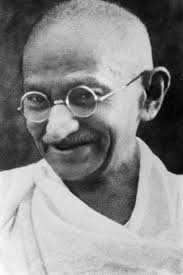 For about three or four years, I had also been reading a lot of Mahatma Gandhi’s books. He talks a lot about spirituality; not very openly, but it is certainly a very strong theme of everything he did. I cannot say, however, that I was seriously looking for a spiritual book when I found the Autobiography; that book was simply a major shifting of lanes for me. Although I respected spiritual people, Autobiography of a Yogi is when I came to know the true potential of man for the first time, and of course, in Kriyananda ji I found a living example of that.
For about three or four years, I had also been reading a lot of Mahatma Gandhi’s books. He talks a lot about spirituality; not very openly, but it is certainly a very strong theme of everything he did. I cannot say, however, that I was seriously looking for a spiritual book when I found the Autobiography; that book was simply a major shifting of lanes for me. Although I respected spiritual people, Autobiography of a Yogi is when I came to know the true potential of man for the first time, and of course, in Kriyananda ji I found a living example of that.
What happened during that one and a half years between your meeting Kriyananda ji and joining Ananda? What made you go and then come back?
(laughs) I had hoped that I would be accepted earlier, after that letter I wrote to Swami ji in which I said: “I’m a doctor, I like to do environmental projects, I could help senior citizens, I could do different kinds of seva. Should I come? I think you’re my Guru, or perhaps Yogananda ji is my Guru. My phone number is this, my email ID is this.” But I never heard from him. So, I truly believe that it was not yet my time, and there was perhaps karma which I had to burn, which is to say that I had lessons to learn. You can’t get something of very high value, like Ananda, just so easily. So, I reflected more: do I have desires in the world still? Do I have karmic debts to pay?
Those one and a half years were extremely intense, but very, very formative for me because my surgical training started very soon after I met Swami ji for the first time. I was serving very intensely and joyfully, but I think I had to come to the point, inwardly, to see that you have to be prepared for spirituality, even on a subconscious level. Consciously I was ready, but I think subconsciously there was a debt to pay off, and that payment happened during that time. Maybe to be a surgeon and serve intensely was a subconscious desire of mine which got satisfied, and thus, when I came on the spiritual path afterwards, I didn’t have any kind of regrets like: “I should be there,” “should I have done more?” or “should I strike a balance?” I think that’s what happened during those one and a half years.
So, you met Swami Kriyananda. My next question is: as far as young people go in India, you certainly got to spend more time with him than most. What were your experiences with him? What is the first thing that comes up when you think of him?
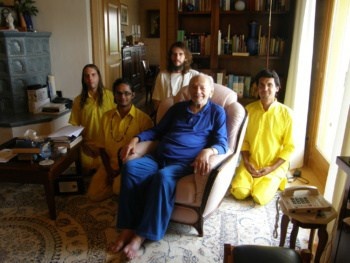 Well, the first thing that stood out when I saw him with the other monks, when I first joined the monastery in 2008, was his radiance. There was a light around him; he was very human, and there was also a radiance, and I knew that here is a man who is very human and practical. That is the fruit of spirituality. Sometimes spirituality can be removed from day to day life, but it was not the case with him. I saw that in everything: in his house, his life, the team around him. I would say, perhaps, that I was actually most struck by his simplicity: there was a certain simplicity to his practice. He was reachable to everybody.
Well, the first thing that stood out when I saw him with the other monks, when I first joined the monastery in 2008, was his radiance. There was a light around him; he was very human, and there was also a radiance, and I knew that here is a man who is very human and practical. That is the fruit of spirituality. Sometimes spirituality can be removed from day to day life, but it was not the case with him. I saw that in everything: in his house, his life, the team around him. I would say, perhaps, that I was actually most struck by his simplicity: there was a certain simplicity to his practice. He was reachable to everybody.
That was your first impression, but as you continued your association with him, what was the most salient characteristic that you noticed in him? What touched you the most?
His insights into how each individual person can make the best progress. To put it more simply, I think he had a very deep and practical understanding of what would help every one uniquely. To give an example: very few people at that time around my circle were appreciative of my starting of a rural clinic as a doctor. But Swami ji said it even without my even mentioning it. As soon as he knew that I’m a doctor, he said: “You could go to Pune and start a rural clinic.” and he also said: “You have done the right thing by coming on the spiritual path.” That kind of a reply was as if my higher self was talking to me, and encouraging me, whereas up till that time I had been busy putting out fires with friends, relatives, colleagues, and so on. So, I think I was very impressed by the fact that he had no personal bias or agenda.
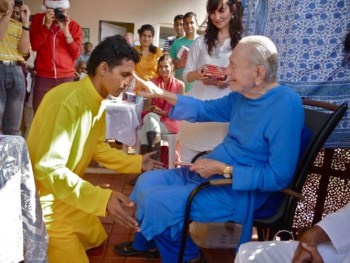 I was also inspired by his lack of preoccupation about his illnesses and about his end-of-life stage; he was always concerned with other people’s realities.
I was also inspired by his lack of preoccupation about his illnesses and about his end-of-life stage; he was always concerned with other people’s realities.
Also, as I came to know over the years, he was extremely international, or universal, in his approach, in his desire to share the teachings. He didn’t have a fixed approach, that he was an American and this is how things should be. In Italy he was one way, in India he was one way. He was very wise; extremely wise, and this I get to learn more and more as I get to know him more.
You say “as I get to know him more.” He left the body five years ago now. What influence does he still have on you? Is it an active influence still, or more of a passive one?
No, it is an active influence because, see, we’re all trying to improve ourselves, and having had the blessing of spending time with him gives clarity to our journey. For me, personally, he gave a lot of clarity: he asked me to share Yogananda ji’s teachings and do medical service, in that order. He also asked me once not to give up! (laughter). You know, things like that.
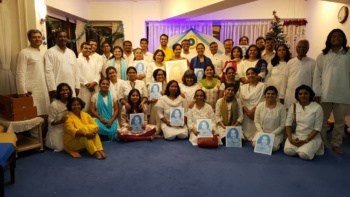 It has been five years, and of course it is wonderful to have someone in the body with whom you can bounce off your queries on a daily basis and such, but I think, as many people have been saying, that attunement at some point or the other has to become an inner experience. It has to be felt inwardly. For me, this often means asking the question: “how would I serve if Swami ji was around?” Because I did have the blessing to be around him, and I remember my energy level at those times, and I remember his expectations from us all. I try to always keep my energy at that level, and that is when I actually see things work out. When I look back, I can clearly see the divine hand in certain projects, in certain accomplishments we have had. And by and large people are happy, they are getting clarity.
It has been five years, and of course it is wonderful to have someone in the body with whom you can bounce off your queries on a daily basis and such, but I think, as many people have been saying, that attunement at some point or the other has to become an inner experience. It has to be felt inwardly. For me, this often means asking the question: “how would I serve if Swami ji was around?” Because I did have the blessing to be around him, and I remember my energy level at those times, and I remember his expectations from us all. I try to always keep my energy at that level, and that is when I actually see things work out. When I look back, I can clearly see the divine hand in certain projects, in certain accomplishments we have had. And by and large people are happy, they are getting clarity.
Another time, Swami ji told me: “I just want you to make the teachings practical.” There is a lot that can be done in this regard. For example, why should people eat vegetarian food? How can they be healthy? How can they overcome certain habits? And of course, how can they bring Kriya practice, devotion in daily life? Do they need a Guru? I consider all of these things practical. You know, they are spiritual, but spirituality should be actually a practical science. As long as I’m being practically helpful to people, I feel in tune with him. So, those few things he said are my guideline, they inspire me, I try to keep them in mind.
You have used the word “practical” a many times since the beginning of the interview. Why? Here you are in the spiritual path, and practicality is not something that people often associate with spiritual teachings. And yet, the first thing you said is that if these teachings are not practical, you didn’t want them.
Yes, see, I think there was a phase in my life, lasting maybe two or three years, in which I believed in the presence of God, but my mind was saying: “IF there is God and He is so great, why am I not able to know about him? Why are others not concerned about him?” So, practicality to me means: does moving in that direction give you happiness? Are certain dilemmas getting resolved? Are you getting any tangible benefits in your relationships? Are you more successful? If you want to be successful, can this help you? Can you have a lot of money and outward signs of success but also be spiritually accomplished? In India, there is often this misunderstanding that the less you have in terms of possessions, the more spiritual you are, or the faster can be your progress.
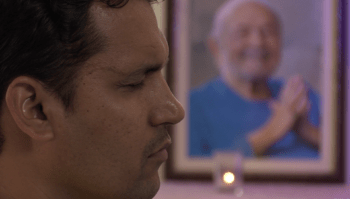 By the time I found these teachings I was already a doctor, I had this skill, and I was looking to tie this skill into spirituality. What I found is that, at some level, everything can be brought up to that high standard: Just yesterday I was reading from the Gita as explained by Swami ji, and it says that in the times of the Vedas, which was a very high age, there was no concept of which is the best time to meditate, or the best place to meditate; no concept of even gunas! Those teachings came in as humanity devolved and their mind needed more convincing.
By the time I found these teachings I was already a doctor, I had this skill, and I was looking to tie this skill into spirituality. What I found is that, at some level, everything can be brought up to that high standard: Just yesterday I was reading from the Gita as explained by Swami ji, and it says that in the times of the Vedas, which was a very high age, there was no concept of which is the best time to meditate, or the best place to meditate; no concept of even gunas! Those teachings came in as humanity devolved and their mind needed more convincing.
Everything is sacred. Everything should be infused, or touched, or part of spirituality. Thus, spirituality, as Swami ji would say, is the most practical thing to do. So, for me the question becomes: how can we make a bridge between worldly and spiritual realities? For example, how can meditation help me? Is it worth my time? Are these exercises worth my time? Is yoga worth my time? Can affirmations really change me? Is a Guru really required to attain the highest in life?
So, these are all questions that you genuinely had?
I genuinely had them, and when I read Autobiography of a Yogi I found all these answers, because Yogananda ji simply knew, and he knew much more than anybody else that I had read about or known! I mean, he taught yoga to Mahatma Gandhi, who, to me, was quite an accomplisher in this world. And it makes sense, also, because everybody needs to be guided, and who guides you beyond the mundane? Beyond the day to day of what we know? That’s why it is very practical to have a Guru.
Read part 2 of the interview: “The Role of Spirituality in Modern Life”
Dr Aditya Gait MBBS DNB(I) is a Medical Doctor and Spiritual Director of Ananda Sangha Pune. He is a Yoga Alliance certified International Yoga and Ananda Healing Teacher. Dr. Aditya offers professional advice to the Yogananda Charitable Trust and has conducted workshops on Health, Happiness and Success at various forums in India, Europe and America. He has conducted programs for global industry leaders such as Tata Management and Training Center (TMTC), Infosys, Amdocs, Apollo Hospitals, and Metro.



